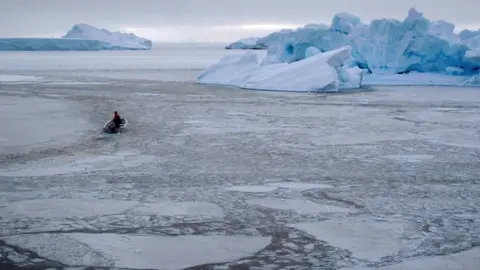Greenland’s ‘unusual’ melting sea ice captured in stunning image
 Steffen Olsen
Steffen OlsenWith their sled in tow, a pack of dogs trudge towards a distant mountain range in north-west Greenland.
The stunning picture may seem typical enough of the Danish territory. What's beneath their feet - a shallow pool of crystal-blue water - is anything but.
Last week, however, temperatures soared well above normal levels in Greenland, causing about half of its ice sheet surface to experience melting.
And the sea ice around the territory is, of course, also feeling this heat.
Steffen Olsen, a climate scientist at the Danish Meteorological Institute (DMI), took the photo on 13 June as these warming conditions reached their peak.
Mr Olsen and his team were retrieving equipment from a weather station in the Inglefield Fjord area. As they walked across the 1.2m (4ft) thick sea ice, water pooled on the surface.
On Twitter, his colleague at DMI Rasmus Tonboe later shared the image, telling followers "rapid melt" had occurred.
Because the sea ice is compact with almost no cracks, the image gives the impression the dogs are walking on water, Martin Stendel, senior researcher at the institute, told the BBC.
Allow X content?

On that day, Greenland is estimated to have lost the equivalent of 2bn tonnes of ice. Temperatures, according to the European Centre for Medium-range Weather Forecasting, were around 22C above normal the day before. In the village of Qaanaaq, a high of 17.3C was recorded.
Since then, Mr Olsen's photo has been shared widely on social media, provoking concern at the extent of the melting event and its causes.
Greenland's ice sheet melts annually, with the season usually lasting from June to August. The summer months - typically in July - are when it reaches its height. This year, however, climate experts say it is early.
Allow X content?

"It's very unusual to have this much melt so early in the season," William Colgan, senior researcher at the Geological Survey of Denmark and Greenland, told the BBC.
"It takes very rare conditions but they're becoming increasingly common."
Mr Colgan compared the melt to 2012, when record-breaking ice sheet loss was recorded in Greenland. He said the same two factors were thought to have caused last week's ice melt and the historic event of 2012.
One is high pressure lodged over Greenland, creating warm and sunny conditions. The other is low cloud cover and snowfall, meaning solar radiation can strike the ice sheet surface.
Global warming, Mr Colgan said, was "tremendously important" to these sorts of events.
 Reuters
Reuters"What climate change is doing is increasingly loading the dice to set up weather conditions that can tip the ice sheets into these mass loss events," he said.
If these trends continued, said Professor Edward Hanna, a climate scientist at the University of Lincoln, Greenland could experience a record melt this year.
"The thing is, with climate trends, as we've seen over the past 20 years, as it gets warmer and warmer over Greenland, you don't need that much of an exceptional event to melt the whole surface of the ice," he told the BBC.
The consequences, he said, would not only be felt locally but globally, too.
 Polar Portal
Polar Portal
As sea ice disappears, local communities who rely on it for transport, hunting and fishing are expected to suffer. On a global level, Prof Hanna said "sea level rise is the big one".
"You're losing something like 250 billion tonnes of ice a year on average. A huge mass is being transferred from the land into the oceans," he said.
Mr Colgan said we should be mindful that the melt on 13 June was just "a one-day event that is surprising in its magnitude and its early onset".
As studies showed, he said, global warming could mean more extreme melting events were yet to come.
"We can expect to see more of these in the future," he said.
